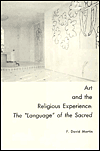Art and the Religious Experience: The "Language" of the Sacred by F David Martin, 257 pages
 This
is an analysis, from a perspective grounded in Heidegger's ontology and
Whitehead's theory of perception, of the nature of art, and especially
the religious dimension of art, whether implicit or explicit. In this
view, true art is an immanetization of the transcendent, a pointer to
the depths of reality which underlie shallow surface appearances. As
such, the aesthetic experience, properly understood, is a participative
experience which involves a relationship with Being itself.
Furthermore, since Being-as-Being cannot be apprehended through sense
data, the aesthetic is an indispensable element in the analogical path
to God. Different types of art utilize different approaches to this
Mystery, whether the unfolding of music from the freedom of temporal
possibility, the immediate visual presence of the surface of an abstract
painting, the retrospective foundations of literature, or the
manifestation of space in architecture.
This
is an analysis, from a perspective grounded in Heidegger's ontology and
Whitehead's theory of perception, of the nature of art, and especially
the religious dimension of art, whether implicit or explicit. In this
view, true art is an immanetization of the transcendent, a pointer to
the depths of reality which underlie shallow surface appearances. As
such, the aesthetic experience, properly understood, is a participative
experience which involves a relationship with Being itself.
Furthermore, since Being-as-Being cannot be apprehended through sense
data, the aesthetic is an indispensable element in the analogical path
to God. Different types of art utilize different approaches to this
Mystery, whether the unfolding of music from the freedom of temporal
possibility, the immediate visual presence of the surface of an abstract
painting, the retrospective foundations of literature, or the
manifestation of space in architecture.
Martin deals
deftly with his subject, but this book is even more interesting for the
manner in which it touches on a variety of ideas and perspectives which
are outside the scope of this book. This is the kind of book that is as
valuable for the thoughts it provokes as the ideas it presents.
No comments:
Post a Comment